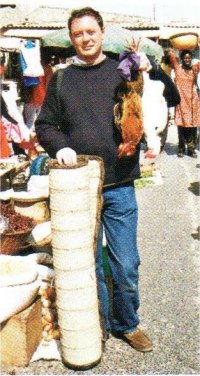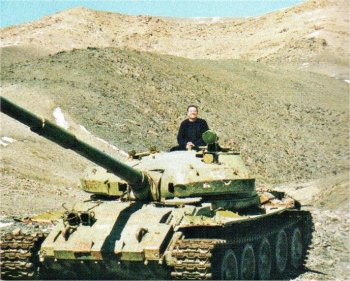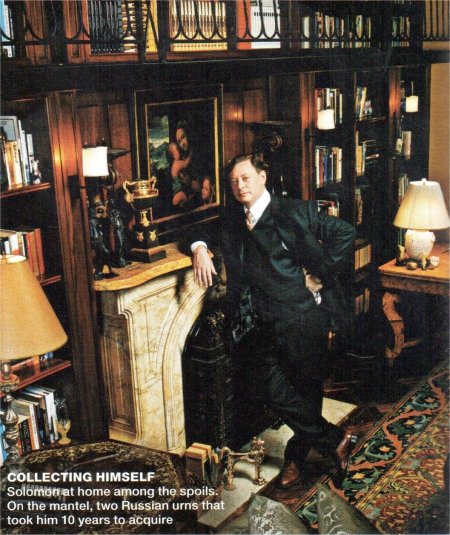To build a great antiques collection, learn how to bargain in a war zone.

The author buys supplies for an n’deup (healing ritual), Senegal, 2000.
My memory has always been extremely poor. I seldom remember people, and events slip away rapidly. The police recently asked me to identify someone who had held me up on the street a week before, and I had to tell them that I didn’t remember what he looked like–not how tall he was, what coloring he had, or what he was wearing. At parties, people take umbrage because I don’t have any idea that I’ve met them before. I cannot remember the ages of my nephews, the way to my friends’ houses, anyone’s phone number, or the plot of Middlemarch, the book about which I wrote my dissertation. That is why I became a writer: because writing things down makes them permanent. My prose stands in for these perpetual losses.
Travel is my overarching passion, and it always has been. Those first childhood trips to faraway places were my idea of heaven–the more strange and obscure the destination, the better. In a parlor game recently, I managed to name sixty countries I had visited, and as I write this I have plans to visit two more in the next six months. I always thought it would be exciting to see every inch of the globe, and I’m working on it.
I cling to my travels in part by writing about them, but I like to have some more documentary evidence of where I’ve been and what I’ve done, beyond the snapshots I seldom have time to peruse. And so I buy things. When I was a child, I was allowed to buy one thing from each trip, and my mother and I would confabulate about what was specific to the place we were visiting: a glass swan in Venice, a carved jade chop in Hong Kong, a straw hat with donkey ears in the Bahamas (of these, only the jade chop survives). I understood that there was a single object that was the apotheosis of each place and that it was a treasure hunt to find it. To buy anything that was not both beautiful and different from all the other things in the world was somehow to miss the point.
Nietzsche once said that only that which is painful is truly memorable, and my accumulations are usually best served if there is some element of struggle in the process of acquisition. In the easiest instances, the struggle is primarily to do with bargaining. I first saw my dining table in the window of a dealer in London in 1989. It cost a great deal more than I could possibly afford. Every time I was in London, I would go to visit it, and every time it was in the window (in large part, I later learned, because it was so difficult to move and had been wedged in place). My love for it only grew. Made by the Bath Furniture Makers to demonstrate the full range of their artisans’ skills and secure the commission to design fittings for the Queen Mary, it is doughnut-shaped, with a central fluted column surmounted by a bronze statue of the Three Graces dancing around a marble pool, and it seats sixteen comfortably. After two years of gazing at it, I walked in one day and said to the dealer that I would offer him half what he was asking, in cash, that day, but that I wasn’t open to any further negotiation. Some blusterous protest ensued, but in fairly short order he agreed. Alas! The table wouldn’t fit through my front door, and so it went into storage. When I bought the house where I currently live, my father said, “Oh, I see you finally got a house to go with that table of yours.”

The author shopping in Jaipur, India, 1999.
A few years after I secured the dining table, I was in Moscow for the fall of the Soviet Union and helped in the resistance movement against the hard-liners; I was present when Yeltsin rode up to the Russian parliament and declared a new state; and a photo of me on a tank was published in The New York Times Magazine and did much to boost my reputation. What was not clear in that photo was the fact that I had at my feet a pair of battered bronze Empire urns with gilt fittings, which I had bought that day for a song from one of the newly established antiques dealers of Moscow, a man who feared that the city might go up in flames or fall prey to a new Stalinism and was thrilled to get any amount of hard currency. I had spent the morning helping to build barricades against the Soviet troops, bought the urns during a lunchtime break, and spent the afternoon at the heart of the action. Let it not be said that urgent political engagement precludes connoisseurship; in my experience, the two go hand in hand.
There were tight rules around the export of cultural property, but I was optimistic that these would not be enforced during the Soviet coup. This proved naïve; the authorities at the airport searched my bags and tried to confiscate the urns. Aware that there was a chance of such an event, I had asked the Russian friends who brought me to the airport to come with me to customs, and I gave them the urns to take home and went back to New York without them. Every year for the next 10 years, I came to Moscow and attempted to take the urns with me, but my bags were x-rayed every time. I applied to the Ministry of Culture for an export license, which seemed straightforward enough; the urns were hardly a national treasure. But there had been a special regulation forbidding the export of decorative metal objects from the early 19th century, and my contact at the ministry said he could do nothing. Finally, I came to Russia one summer via Mongolia, and Russian export law did not apply to items purchased there. A friend in Moscow suggested that we doctor some of my Mongolian papers to say that the urns had been bought in Ulaanbaatar. I do not like dishonesty, but I felt it was the only way. When I got to the airport in Moscow with the urns and the papers, my heart was beating at deafening volume. For the first time in ten years, they waved me through; I was never asked to produce the false papers I had so carefully prepared.
In China in 1993, where I went to research an article about the demise of the old order, everything seemed to be for sale. At the Jinsong flea market, I found a stall full of Qing-dynasty carved panels from the houses of southern merchants, lacquered dark red with splashes of gold, and I bought two pairs of them, each pair the exact width of a king-size bed. A Chinese friend helped with the bargaining–I had to pretend not to be interested and then let him go and negotiate, because if they had seen a Westerner the price would have tripled. After some banter, I was able to get them for $41. Then came the perpetually vexing question of export. The panels were of no artistic significance, but they were old, and customs could be tough about exporting old things. Friends told me that even though my flight out of Beijing was not until 4 P.M., I should get to the airport and walk through customs around 8:30 A.M., as that was when the customs officers tended to have their tea and they would wave anyone through. I was there bright and early, and I strolled through with my prized carvings without being asked a thing. I negotiated with the stewardess to bring them into the cabin for the flight to Tokyo; and with the next stewardess for the flight to Los Angeles; and with the next stewardess for the flight to Seattle; and with the ferry captain for the journey out to the San Juan Islands for a wedding; and with the ferry captain on the way back; and when I got to the stewardess for the flight back from Seattle to New York, she said no, no, no, out of the question. So I slept overnight in the Seattle airport and bullied my way onto a flight the next morning with a more amenable stewardess, to whom I explained the drama, the tribulation, and the fragility of the items. I also allowed her to think that I was acting as a courier for the Metropolitan Museum of Art, which I think helped my cause considerably. A friend designed a bed around the panels, and every night I look at them and think with satisfaction of the process that brought them home.

The author surveys the Panjshir Valley war zone, Afghanistan, 2002.
Reporting in Afghanistan immediately after the fall of the Taliban, in February 2002, I happened to pass on a snowy day by a little hovel in which there was a panel of Herati tile work, rather dirty but very lovely. I expressed admiration, and the owner offered it to me for sale, though he invited me first to feel how heavy it was (almost fifty pounds). After some teatime charm and a bit of music and a shared kebab and the exchange of a little money and many promises, I left bearing it triumphantly, blessed a thousand times by its owner, who told me he could feed his family for the winter on the proceeds. The following day, I paid a visit to a great calligrapher who was living in a state of impossibly degraded poverty, and as a gesture of goodwill, I bought his rendering of a Koranic text, exquisitely done on frail paper. When we got to the border, the authorities tried to take away both items, but my brilliant translator made a great fuss, and after some bellowing back and forth in Dari, I was waved through. Then I carried these two items from Kabul to Islamabad to Dubai to London to New York. The panel was badly cracked, and therefore extremely fragile; a bad bump and it would break in half. The paper, on the other hand, was subject to crushing, and there was no such thing as a cardboard tube to be found. The panel had to go in one hand and the paper in the other, which left my carry-on luggage dangling from a shoulder strap and my passport in my teeth. I returned victorious.
There is of course a philosophical question attached to removing such things from their countries of origin. I joined the board of the American Council for Cultural Policy a few years ago in order to press more effectively the urgent cause of collecting. I believe that a work should go where it will be best cared for. There need to be laws to prevent the new export of major cultural patrimony from its country of origin, and it is important not to encourage a market in looted antiquities, since the looting defaces archaeological sites. But I provide a loving and temperature-controlled home for material that would otherwise likely be chipped or torn or neglected, material that I generally find in rather poor condition and valiantly save. The items mentioned above have all had protracted visits to restorers; I preserve their health as I would my own.
I lived in London for some years in my 20s and took a second passport. I had an expatriate’s nostalgia for home and eventually moved back; but I had lived abroad long enough so that I am always yearning for the domestic pleasure of another country. In the poem “Questions of Travel,” Elizabeth Bishop wrote, “Think of the long trip home. / Should we have stayed at home and thought of here? / Where should we be today?” That is how it has always been for me: The things I buy on my travels make me feel that I incorporate the places where I am not; they are tokens of the hugeness of the earth. I am at once dwarfed and made splendid by them.
When I walk through the memory palace in which I live, my past seems to be with me. I remember the day I bought the Biedermeier secretary in Stockholm, the iron desk chair in Jaipur, the beaded coffee jug in Durban, the study carpet in Gocek, the tapestry in Paris, the refrigerator magnets in Minneapolis, the Kazakh huntsman’s cup in Almaty, the war clubs from a tribal elder whom we had to row half a day to visit in a remote corner of the already-remote Solomon Islands. The Cambodian silver box reminds me how I went to study depression among survivors of the Khmer Rouge, and the polar-bear skin nailed to the guest-room wall conjures my time with the Greenlandic Inuit; the Mongolian chatelaines in my dressing room, silver and enamel, bring back the close air of the yurts and the taste of boiled yak fat. I keep the Tunisian chairs from Tunis on each side of the medieval Danish chest I bought in Copenhagen when I was in love with a Dane; on that chest sit the Hungarian candlesticks I bought in Budapest when I was in love with a Hungarian. My wastebasket is a 17th-century scroll pot that I picked up in Bangkok, and my Iznik bathroom tiles came from a visit to Istanbul.
Few of these things are valuable in financial terms, but they are valuable to me for their beauty and for the stories behind them. My life, which I cannot contain in my own mind, is so recorded around me that it remains always present, always vital. Tennyson’s Ulysses declares, “I am a part of all that I have met.” All that I have met is a part of my house, and this ensures that it remains always also a part of me.

The author in his library. On the mantel, two Russian urns that took the author 10 years to acquire.











